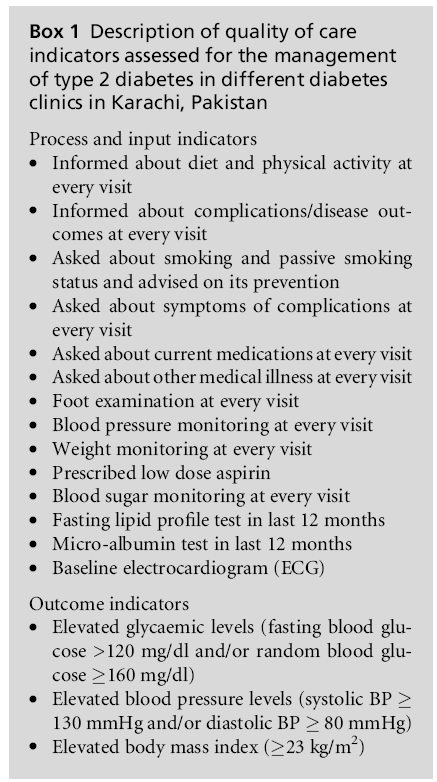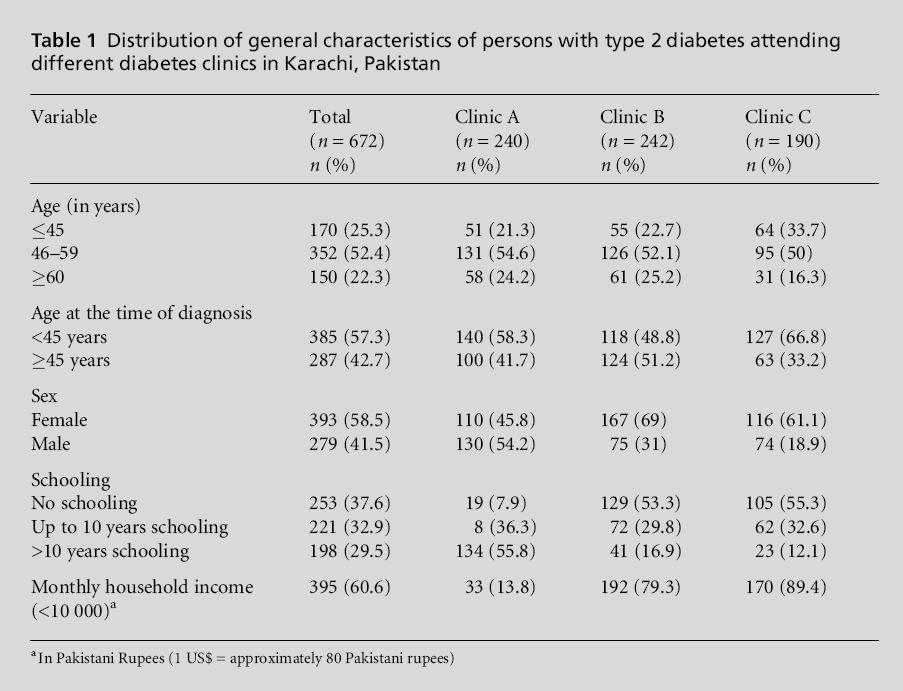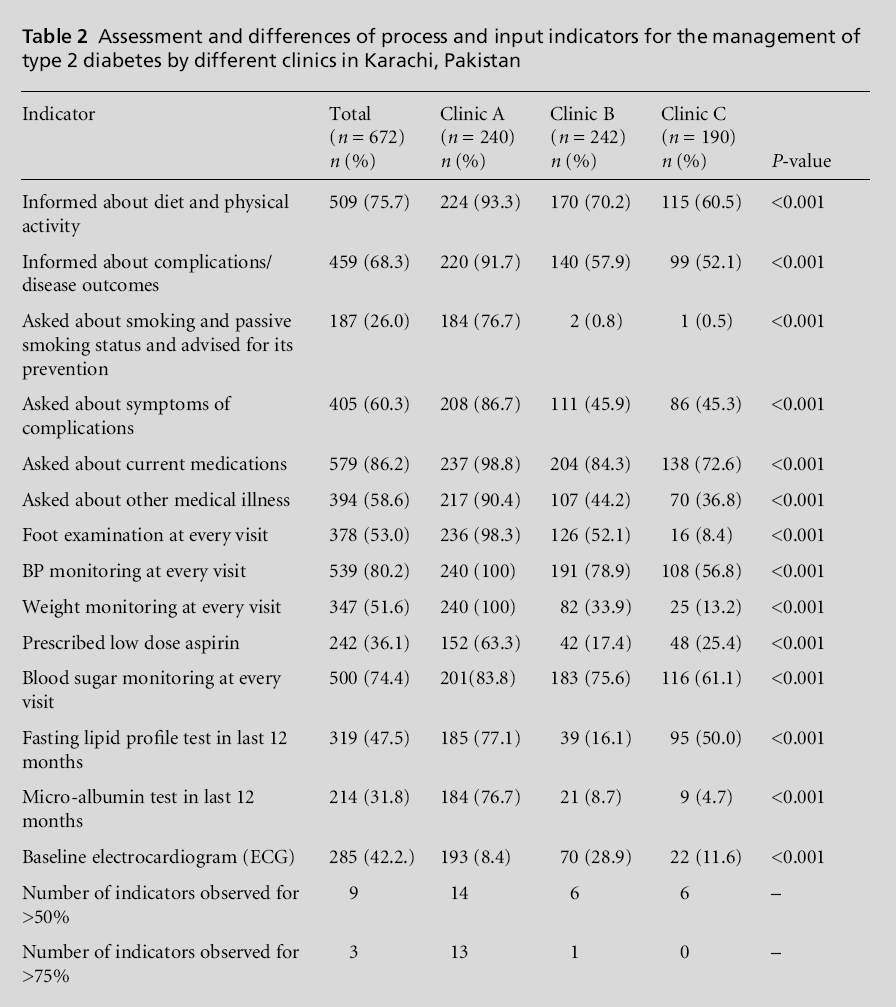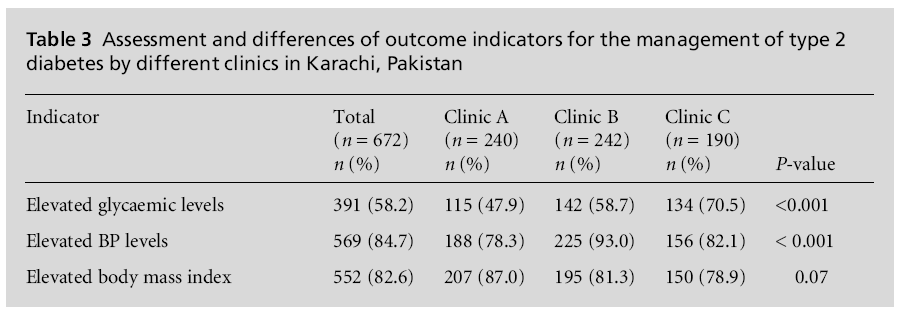International Exchange - (2010) Volume 18, Issue 3
Assistant Professor, Department of Community Health Sciences
Ali Khan Khuwaja MBBS MCPS FCPS*
Assistant Professor and Convener Research, Department of Family Medicine
Ghazala Rafique MBBS MPH FCPS
Assistant Professor, Department of Community Health Sciences
Aga Khan University, Karachi, Pakistan
Franklin White MD CM MSc FRCPC
President, Pacific Health and Development Sciences Inc.,Victoria BC, Canada
Received date: 11 September 2009; Accepted date: 12 January 2010
Background Complications of diabetes can be prevented or delayed by providing high quality care. This study aimed to document the quality of care provided to people with type 2 diabetes in Pakistan and to identify the difference in care offered at various clinics.Design Cross-sectional multi-centre study. MethodsInterviews were undertaken with 672 people with type 2 diabetes attending three different types of diabetes clinic (private clinic (A), nongovernmental organisation (B) and public clinic (C)) in Karachi, Pakistan. A structured questionnaire was used to collect socio-demographic and clinical information from patients; quality of care indicators were also confirmed by reference to patients’ medical records. ResultsOverall, 68% (A: 92%, B: 58% and C: 52%, P0.001) of study subjects were informed about diabetes complications. Blood pressure (BP) monitoring at every visit was completed for 80% of study respondents (A: 100%, B: 79% and C: 57%, P0.001). Foot examination was infrequent (53%, A: 98%, B: 52% and C: 8% (P0.001). Lipid profiles of 48% of patients had been done in the past 12 months (A: 77%, B: 16% and C: 50%, P0.001). Microalbumin testing had been performed in 32% of patients in the previous year (A: 77%, B: 09% and C: 05%; P0.001). Most participants had elevated glycaemic (58.2%) and BP levels (84.7%) with higher prevalence among people who attended clinics B and C (P0.001). Overall, 82.6% of study subjects had an elevated body mass index; this was almost equally prevalent across clinics. ConclusionMany patients with type 2 diabetes do not receive optimal diabetes care in Karachi. Among the different settings, care provided in private health sector clinics was of a better standard. However, our results reveal a need for overall improvement in the quality of diabetes care. Further research is also needed to evaluate the reasons for poor diabetes care, and to identify the most cost-effective means to address these.
developing country, disease management, quality of care, type 2 diabetes
How this fits in with quality in primary care
What we do know?
Good quality of care for diabetes management significantly decreases complications, costs and premature mortality. However, provision remains a challenge for healthcare providers. Substantial data are available from developed as well as developing countries; they reveal the poor quality of care provided to people with diabetes.
What does this paper add?
This study is the first fromPakistan on diabetes, which is increasing rapidly in prevalence. Overall, this study identified gaps in the management of diabetes but the care provided in public sector and non-governmental organisation clinics is of particularly concern. Even comparatively low-cost measures (such as patient education and foot examination) were not performed properly. This study prepares the ground for further research and interventions in Pakistan.
Diabetes mellitus has been described as a modern pandemic which is growing rapidly, particularly in developing countries including Pakistan.[1,2] In the year 2000, there were five million people with diabetes mellitus in Pakistan and it is projected that by the year 2030 this number will rise to 14 million[1] unless preventative strategies are deployed.
Diabetes is a chronic metabolic disease that involves virtually all organ systems of the body, resulting in acute and chronic complications. These often lead to prematuremorbidity andmortality associated with high healthcare costs, lower productivity and poor quality of life.[3–6] Compared to microvascular complications, macrovascular complications aremore prevalent among people with type 2 diabetes.[7] In the UK Prospective Study (UKPDS), nine years after the diagnosis of diabetes, 20% of patients had macrovascular complications compared to 9%who had microvascular complications. 7 Macrovascular complications more often result in hospitalisation, deaths and cost utilisation among people with type 2 diabetes.[8,9] However, evidence suggests that better quality of care can significantly reduce diabetes related complications, deaths and economic costs.[3,9,10] According to the UKPDS,[10] among persons with type 2 diabetes a decrease of1%in glycosylated haemoglobin (HbA1c) reduces the incidence of myocardial infarction by 14% and of diabetes related death by 21%. Similarly, tight control of BP significantly decreases the incidence of macrovascular complications and related deaths.[11]
Diabetes requires comprehensive and continuous management and is a complex challenge for healthcare providers. A number of management guidelines and protocols are recommended by different international federations and associations.[12,13] Nevertheless, large numbers of studies both fromdeveloped and developing countries have identified major gaps in the quality of care provided to people with diabetes. According to one study from the USA, only 33% of people with diabetes received the recommended HbA1c testing and 58% had their feet checked by a health professional within a one-year period.[14] In the UK, BP was checked in 84% and smoking status in 64%,while only 1% of patients with diabetes had been assessed for urinarymicro-albumin within the previous 15months.[15] In Thailand, total cholesterol and triglycerides had been determined only in 17% and 7% of adults with diabetes respectively in the preceding year;16 similarly, a wide gap between practice recommendations and delivery of diabetes care has been reported from Delhi, India.[17]
Like many other developing countries, Pakistan has poor economic and health indicators,[18,19] with fragile health systems where affordability and accessibility to health facilities are limited. There have been no prior published studies on the quality of care for diabetes in Pakistan. We aimed to identify the quality of care provided to people with type 2 diabetes and to estimate differences in care provided by three diabetes clinics operating within different administrative arrangements in Karachi, Pakistan. The information obtained by this study will help to design better healthcare programmes and intervention strategies for persons with diabetes in resource constrained countries like Pakistan.
This was a clinic based cross-sectional study conducted at private, non-governmental organisation (NGO) and public sector clinics in Karachi, the largest city and economic capital of Pakistan, with an estimated population of over 14 million from many different ethnic and socio-economic groups. Clinic A is attached to a tertiary care teaching hospital representing the private sector. It is fully supported by an inpatient facility with the latest diagnostic and therapeutic equipment. Clinic B is run by an NGO. It deals with a large number of people with diabetes and provides treatment to them on an outpatient basis only, referring patients to other hospitals when they need hospitalisation. Clinic C is attached to a tertiary care teaching hospital representing the public sector, with back up inpatient hospital facilities. In general, private sector clinics charge substantially higher consultation fees compared to public sector and NGO clinics.
We included all patients with type 2 diabetes who had attended a clinic for more than one year, returned for follow-up during the study period and gave their consent to participate in the study. Women who were pregnant at the initial visit were excluded from the study because the management criteria for pregnant woman are different from other people with diabetes. Overall, 672 subjects from all three clinics were interviewed by medical graduates. All interviews were ‘exit interviews’ (after consultation with the patient’s physician) undertaken in a separate room not connected to the care provider’s reception area.
A structured questionnaire was used for data collection. This was first designed in English and comprised different sections: general patient characteristics (sociodemographic and disease related) and quality of care indicators which are related to macrovascular complications (ischaemic heart disease, cerebrovascular disease and diabetic foot). We inquired about macrovascular complications (Box 1), with indicators derived from the international guidelines for the management of diabetes.[12,13] A checklist was used to verify the quality of care indicators from each patient’s medical record. The questionnaire was translated to Urdu and then back to English to identify any change in meaning or phrasing. Pretesting of the questionnaire was conducted in another diabetes clinic of a tertiary care teaching hospital, situated in Karachi, following which amendments were made where required.

Descriptive analysis was done to describe the personal characteristics of study subjects and of the quality of care indicators provided. Differences in quality of care for different clinics were evaluated for statistical significance using chi-square tests.
We approached 240, 242 and 190 study participants from clinic A, clinic B and clinic C respectively. The characteristics of participants are presented in Table 1. Most (77.7%) participants were below the age of 60 years and 57.3% had been diagnosed with diabetes before the age of 45 years. Most subjects were females (58.5%), but in clinic A females were in the minority (45.8%). Overall, there were equal proportions by educational status; however, this varied markedly by clinic (a large majority of study participants at clinic A had schooling of 10 years or more, in contrast to clinics B and C where there was preponderance of study participants having no schooling). This was reflected in the distribution of monthly household incomes. In clinic A, only 13.8% of people had a monthly household income of 10 000 rupees or less per month, whereas most subjects in clinics B (79.3%) and C (89.4%) were in this category.

Assessment of quality of care indicators for management of type 2 diabetes is given in Table 2. Most quality of care indicators for diabetes management were poorly performed, especially in clinics B and C where performance was significantly lower compared with clinic A (P<0.001). The best observed practices were inquiring about current medicines (86.2%) and BP monitoring at every visit (80.2%). The worst performance observed was inquiring about smoking and passive smoking and giving advice on preventing exposure (26%; clinic A: 76.7%, clinic B: 0.8% and clinic C: 0.5%). Altogether, the number of quality of care indicators performed for more than 50% of patients was higher in clinic A than in clinics B or C: 14, 6 and 6 respectively. Similarly, the number of and quality of diabetes care indicators performed for more than 75% of patients was higher in clinic A than in clinics B and C: 13, 3 and 0 respectively.

Diabetes management outcome indicators, overall and by clinic, are given in Table 3. In all, 58.2% of study participants had elevated glycaemic levels; elevated levels were significantly less prevalent in clinic A (47.9%) in contrast to clinic B (58.7%) and clinic C (70.5%). Similarly, a very large proportion of study participants (84.7%) had elevated BP levels and there was again a higher proportion amongst patients attending clinics B and C. Over 82% of study subjects had an elevated body mass index as well; a slightly higher proportion in clinic A (total: 82.6%; clinic A: 87.0%; clinic B: 81.3% and clinic C: 78.9%; P = 0.07).

Many studies have been conducted in different parts of the world to assess the quality of care provided to people with diabetes compared with guidelines and recommendations. However, this is the first study so far from Pakistan to assess quality of care indicators for diabetes management across different types of clinic.
It is reported that in contrast to developed countries, most people with diabetes in developing countries are in the 45- to 64-year age range.1 Moreover, south-Asians develop diabetes and cardiovascular risk factors at an earlier age and with greater severity compared to other ethnic groups.[2,20,21] We found that a majority of study participants were below 60 years of age and had been diagnosed with diabetes earlier.
Socio-economic status, literacy levels and monthly household income were significantly higher in the private compared to the other types of clinic. More females utilised public sector and NGO services compared with the private sector clinic, where there was a predominance of males. This difference might be explained by the majority of females being housewives, with time to visit public sector or NGO clinics which provide services in the morning hours, whereas the private sector clinic provides services at all times of the day. Males generally did not utilise services during the morning hours, possibly due to work or other commitments but might find time to visit a clinic in the evening or might prefer to utilise private clinics. Gender inequity and cultural factors including the practice of seclusion and limited decision-making authority, lower income and reduced access to health services might be other explanations for women being less likely to use private clinics.
Patient education on risk factors, complications and treatment objectives is a cornerstone of diabetes management. Interventions to improve patient education and enhancement of the role of nurses in diabetes care have been shown to lead to improvement in patient outcomes as well as process of care.[22] In our study, two-thirds of patients were educated about dietary intake, physical activity, risk factors and symptoms of complications, with significantly more in the private clinic. In contrast, less than a third of patients were asked about smoking or its prevention. However, a majority of patients were asked about symptoms of complications and other medical illness, significantly more so in the private clinic. This difference may be due to the fact that private clinic physicians spent 15 minutes with each patient on average, followed by a patient education session delivered by a trained diabetic nurse, while in other clinics patient education sessions were not provided and physicians had less time to spend with each patient. In addition, patients at the private clinic were provided with educational brochures and leaflets related to diabetes management and care.
Monitoring of weight and BP are important indicators in assessing the quality of care provided to persons with diabetes and should be monitored at every visit.[12,13] In our study, BP and weight monitoring was done for every private clinic patient, whereas it was more poorly performed in other clinics. The obvious reason for this difference is that in the private clinic it is mandatory for every patient to have BP and weight monitoring at every visit before consulting with a physician and a designated nurse is assigned for this task, whereas this practice is not applied in the other types of clinic. Intake of low dose aspirin is widely recommended for primary and secondary prevention among adults with diabetes.[12,23] In spite of the low cost, prescription of aspirin was very infrequently reported. Only 32% and 36% of adult diabetics were prescribed low dose aspirin in India and the USA respectively.[24,25] The results are very similar in our study as well, where just 36% of study subjects were prescribed intake of low dose aspirin.
Fasting lipid profiles of persons with diabetes should be done at least once a year[12] to manage the dyslipedemia if present or to detect it earlier, as about 50% of people with diabetes also have concurrent dyslipedemia which is strongly related to macrovascular complications.[12] According to a study conducted in India, 68% of people with diabetes had not had their cholesterol tested in the last year.[17] Results of our study are comparable; 52.5% of subjects had not been tested for lipid profile in the last 12 months.
Lower performance inNGOand public clinics (Table 2) may be related to cost. Urinary micro-albumin, another costly test, is well proven as an early predictor of nephropathy and a risk indicator for cardiovascular mortality that ideally should be tested at least once a year.[12] In our study, a majority of participants had never been tested for urinary micro-albumin. Similar findings have been reported from other developing countries.[16,17] Testing for an HbA1c level, another costly laboratory investigation, was performed for only a quarter of the patients (data not shown) in this study, a feature reported in other developing countries.[16,17]
Frequent foot examination as a means of reducing the risk of developing foot ulcers and amputations in persons with type 2 diabetes is widely recommended at least once in a year;[12,13] however, it is infrequently practiced in different parts of the world. In Singapore, only one-third of patients attending general medicine outpatient public sector clinics had their feet assessed.[26] Similarly Barnes et al reported foot examination by their health provider for only 40% of patients with diabetes within the previous year.[27] The overall situation in our study was not much different; only 56% of the patients studied had had their feet checked by their physicians at least once a year. There is again enormous variation by clinic type: in clinic A, 98% of respondents had their feet examined regularly, while in clinic B this was performed on 52% of respondents, while in clinic Conly8%of respondents were reported to have had a regular foot examination. As mentioned earlier, in clinic A, physicians were giving sufficient time to each patient with the assistance of a diabetes care nurse, hence assuring a detailed assessment of the patient which led to increased clinical cost, while in clinics B and C, time was not sufficient for complete assessment, hence the reduction of cost in monetary terms in these clinics.
There is strong evidence that uncontrolled blood glucose and BP levels are risk factors for long-term complications among people with diabetes,[1,2,4] while tight control significantly reduces the risk of these complications.[10,11] However, in our study a large majority of participants had high glycaemic and BP levels. Nevertheless, this proportion was significantly lower in the private clinic, which might reflect better quality of care. Similarly, elevated body mass index, an independent risk factor for macrovascular diabetes complication, [3,12] was common among study participants, and more so in the private clinic where more patients were of higher socio-economic status. This is consistent with evidence that in countries in epidemiological transition the prevalence of obesity is initially higher among people of higher socio-economic status.[2]
This study had important limitations. We assessed information from the preceding 12 months and there is a possibility of recall bias. We were not able to assess the effect of healthcare facilities other than the clinics where the patient enrolled for the study. All three clinics studied were from the same city in Pakistan. Extrapolation to other cities or to the country as a whole is therefore not possible.
In spite of these limitations, gaps were noted in aspects of quality of care for type 2 diabetes compared with international recommended standards.[12,13] Even measures which could be performed with minimal additional cost, i.e. history assessment, patient education and foot examination, were poorly performed. The extent of the gap varied with type of clinic: quality of care was particularly poor in the NGO and public clinics studied, where most patients were of lower socio-economic status than those attending the private clinic.
Greater effort and action is needed to bridge the gap in quality of diabetes care. We recommend that healthcare providers be better trained and educated with regard to disease management, screening, early detection and prompt treatment of complications as well as patient education and counselling. Care providers should provide sufficient time to every person suffering from diabetes for appropriate management of their disease, including more active self-management; designated nurses trained in diabetes management and patient education should be assigned. Given the expanding incidence of diabetes and its complications, health ministries should ensure that all those with diabetes have access to high quality and affordable care.
More research in developing countries is also required to identify the reasons for poor quality of diabetes care and to design and implement costeffective interventions for improvement. There is also a need to formulate standards of care and clinical practice guidelines for the management of diabetes mellitus that are more easily affordable, more appropriate for poor people and suitable for countries with limited resources.
We are thankful to the management and staff of the clinics studied for giving permission to conduct this study and for their support throughout.We are grateful to all the patients who participated. We also acknowledge Drs Hafsa Raheel, Waqar Khusk, Asad Afridi, Nadya Khuwaja and Wahid Bux Soomro for conducting all the patients’ interviews and reviewing patients’ medical files. We are also thankful to Dr Abdul Jabbar, Professor and Section Head, Diabetes and Endocrinology, Aga Khan University, Pakistan for his valuable review of the manuscript.
Not commissioned; externally peer reviewed.
None.